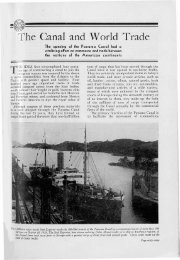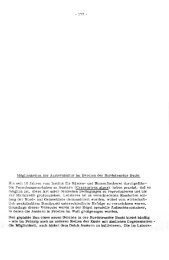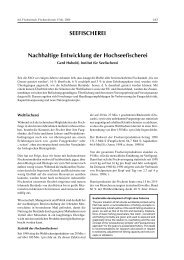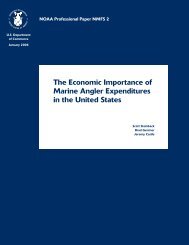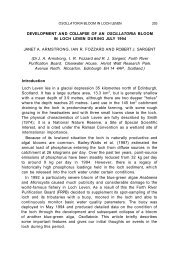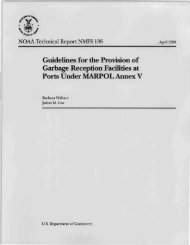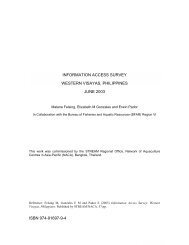Download (1417Kb) - Aquatic Commons
Download (1417Kb) - Aquatic Commons
Download (1417Kb) - Aquatic Commons
Create successful ePaper yourself
Turn your PDF publications into a flip-book with our unique Google optimized e-Paper software.
5.3<br />
Jumars, P.A. (1975). Methods for measurement of community structure in<br />
deep-sea macrobenthos. Mar. Biol. 30, 245-252. [Modified USNEL<br />
spade corer of Hessler & Jumars (1974); called "vegematic box corer"<br />
because the corer is divided up into 25 contiguous sub-corers, each<br />
with sampling area of 100 cm 2 ] R, M, Mar<br />
Kanneworff, E. & Nicolaisen, W. (1973). The 'Haps' a frame-supported<br />
bottom corer. Ophelia 10, 119-129. [Diameter 13.6 cm; gravity corer<br />
supported by frame and with closing plate to act as a core catcher;<br />
similar to box corer of Reineck (1963) but probably lighter (no weight<br />
given)] R, MC, Mar<br />
Kaplan, E.H., Welker, J.R. & Krause, M.G. (1974). A shallow water system<br />
for sampling macrobenthic infauna. Limnol. Oceanogr. 19, 346-350.<br />
[Diameter 36 cm; similar to corer of Knudsen (1927); corer reverses<br />
manually or automatically to retain sample] R, MC, Mar<br />
Keegan, B.F. & Konnecker, G. (1973). In situ quantitative sampling of<br />
benthic organisms. Helgolander wiss. Meeresunters. 24, 256-263.<br />
[Diameter 15 cm; pneumatically operated corer] R, M, Mar<br />
Kermabon, A., Blavier, P. & Cortis, V. (1965). The Saclantcen sphincter<br />
corer assembly. NATO Unclassified Tech. Rep. No. 34. [Description<br />
of corer of Kermabon et al. (1966)] R, M, Mar<br />
Kermabon, A., Blavier, P., Cortis, V. & DeLauze, H. (1966). The 'sphincter'<br />
corer: a wide diameter corer with water-tight core catcher. Mar. Geol.<br />
4, 149-162. [Diameter 12 cm; piston corer similar to that of<br />
Kullenberg (1947) but with 'sphincter' to close lower end] R, M, Mar<br />
Kirpichenko, M.J. (1964). An instrument for collecting samples of bottom<br />
sediments. (In Russian). Sb. Rab. Koms. gidromet. Obs. 3, 174-77.<br />
[Sampling area 20 cm 2 - 2000 cm 2 ; automatically closed with top lid and<br />
bottom curtains operated by springs ] R, M, FW<br />
Knudsen, M. (1927). A bottom sampler for hard bottom. Meddr Kommn<br />
Havunders, Ser. Fisk. 8 (3) 4 pp. [Diameter 36 cm; sampling depth<br />
30 cm; pump used to suck sampler down into sediment then coring tube<br />
inverted to retain sediment] R, M, Mar<br />
Kogler, F.C. (1963). Das Kastenlot. (The box-corer) (In German).<br />
Meyniana 13, 1-7. [Box corer that is longer and has a smaller crosssection<br />
than corer of Reineck (1963)] R, M, Mar<br />
Lang, K. (1930). Ein neuer Typus des quantitativen Bodenschopfers. (A<br />
new type of quantitative bottom scoop) (In German). Arch. Hydrobiol.<br />
21, 147-150. [Diameter 18 cm; gravity corer with five valves in the<br />
lid, no core retainer at lower end] R, M, FW<br />
McManus, D.A. (1965). A large diameter coring device. Deep-Sea Res. 12,<br />
227-232. [Diameter 15 cm; piston corer with spring-leaf core catcher<br />
in lower end] R, M, Mar<br />
Menzies, R.J. & Rowe, G.T. (1968). The LUBS, a large undisturbed bottom<br />
sampler. Limnol. Oceanogr. 13, 708-714. [Sampling area 617 cm 2 or<br />
2490 cm 2 ; gravity corer with canvas or nylon bag to close lower end<br />
and retain sample] R, M, Mar<br />
Milbrink, G. (1968). A microstratification sampler for mud and water.<br />
Oikos, 19, 105-110. [Sampling area 12.3 cm by 13.5 cm; square<br />
plexiglass gravity corer, automatically closes and cuts sample into<br />
strata by means of slides] R, M, FW<br />
36



